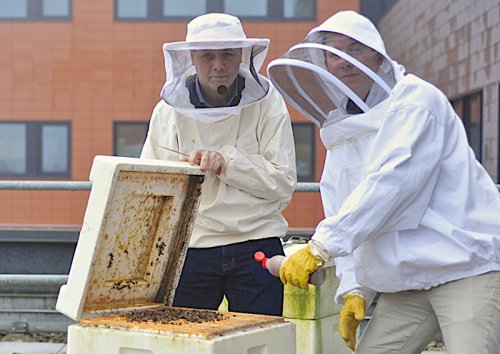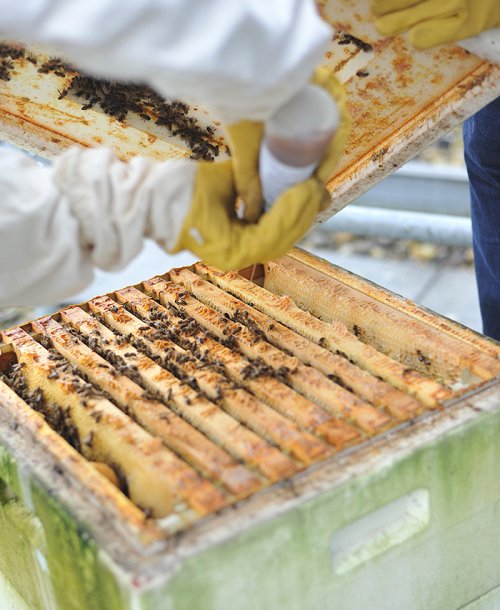Killer collaborators
22 December 2016
When it comes to collaboration, nothing works as smoothly as a beehive. Two bee-keeping colleagues share some lessons from the bees.

Master and apprentice: In peak times, Joost Leendertz and Jurgen Reij manage around 120,000 bees on the roof of the Haarlerbergpark building in Amsterdam.
Joost Leendertz is an agile coach. For those not familiar with that role, it’s a kind of facilitator for the new-fangled agile way of working.
Among other things, Leendertz acts as a protector of the overall project vision. He encourages his teams with daily stand-up meetings. He helps to remove impediments to efficient work flow. He’s a collaborator.
It just happens that Leendertz is also beekeeper. Not just in his spare time, but for ING as well. Leendertz and fellow IT specialist Jurgen Reij, keep a careful eye on three beehives on the roof of the Haarlerbergpark building in Amsterdam. Together with staff from Cisco, who started the project in this building, they manage in peak times around 120,000 bees.
“Bees are the ultimate collaborators,” says Leendertz, who has been a beekeeper for almost 40 years.
No ego
“They’re willing to change their role and even sacrifice their lives for the hive.”
Leendertz sees parallels between bee colonies and the agile way of working. Although for humans the self-sacrifice is one step too far.
“We have squads or teams working together with a shared goal. Most of the time though, they are not as clear and focused as a beehive.”
For a hive to prosper, bees are willing to do what it takes. Workers do not reproduce on their own, and give up their own lives so the queen, and others, can survive to lay eggs in the future. Bees are also prepared to sacrifice themselves by using their stinger when the hive is under threat.
“It’s the ultimate form of collaboration. How can we survive as a team?”
But Leendertz says it's different with people.
“We have our own ego, our own motivation. Sometimes it doesn’t fit. Maybe we can learn from the bees to always put the team number one?”
All equal
Reij, who started a course in beekeeping this year, says there are also parallels with hierarchy.
“There is no hierarchy in the colony. They are all equal. They have different tasks that enable the queen to lay eggs.”
It’s a little like our former business ING Direct Canada, famous for its emphasis on collaboration with no job titles and no reserved car park for the CEO.
Reij says that the only role of the drones is to fertilize a queen. This happens only a few times a year when the virgin, newborn queen takes off on her so-called bridal flight. Chances are a drone never fertilizes a queen during its life, but all drones are equally important given that variety in the gene pool is needed.
“The workers are more adaptable. They move through a series of jobs before finally emerging as food-gatherers. In an emergency they can revert to their former occupations to make up for losses, for example, by feeding larvae or producing wax.”
Letting go
He also draws parallels in management to that age-old dilemma of letting go versus keeping control.
“As a beekeeper you need to keep a certain amount of control to prevent a hive from swarming. But you can’t control it all. You can’t micromanage every bee. You need to manage the whole hive. But if the whole hive is not managed properly the bees swarm and look for another home.”
Bees are also great communicators, using vibrations and pheromones to pass complex messages around their colony. There’s also the fact that they pollinate more than 70 of the top crops that provide 90 percent of the world’s food.
And they produce Mother Nature’s best sweetener. This year, Cisco auctioned off 60 kilos of honey at a charity auction. It’s something that ING will look at doing next year as well.
Also on the cards is the establishment of beehives on the roof of the nearby Acanthus building. This year, Leendertz took Wholesale Banking managers to the hives to explore parallels with self-managing teams.
“It’s a way of not only enhancing ING’s green image, but a fun way to meet new people in another setting and to see in real life the wonders of nature,” says Leendertz.

